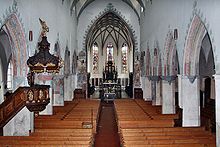
Ulm Minster is a Lutheran church located in Ulm, State of Baden-Württemberg (Germany). It is the tallest church in the world. The church is the fifth-tallest structure built before the 20th century, with a steeple measuring 161.53 metres.

The Basilica of St. Peter and St. Paul is a neo-Gothic collegiate and parish church in Vyšehrad fortress in Prague, Czech Republic.

The Basilica of Saint Francis of Assisi is the mother church of the Roman Catholic Order of Friars Minor Conventual in Assisi, a town in the Umbria region in central Italy, where Saint Francis was born and died. It is a papal minor basilica and one of the most important places of Christian pilgrimage in Italy. With its accompanying friary, Sacro Convento, the basilica is a distinctive landmark to those approaching Assisi. It has been a UNESCO World Heritage Site since 2000.

Rouen Cathedral is a Catholic church in Rouen, Normandy, France. It is the see of the Archbishop of Rouen, Primate of Normandy. It is famous for its three towers, each in a different style. The cathedral, built and rebuilt over a period of more than eight hundred years, has features from Early Gothic to late Flamboyant and Renaissance architecture. It also has a place in art history as the subject of a series of impressionist paintings by Claude Monet, and in architecture history as from 1876 to 1880, it was the tallest building in the world.

The Basilica of the Sacred Heart in Notre Dame, Indiana, is a Catholic church on the campus of the University of Notre Dame, also serving as the mother church of the Congregation of Holy Cross (C.S.C.) in the United States. The neo-gothic church has 44 large stained glass windows and murals completed over a 17-year period by the Vatican painter Luigi Gregori. The basilica bell tower is 230 feet (70 m) high, making it the tallest university chapel in America. It is a contributing building in Notre Dame's historic district listed on the National Register of Historic Places. The basilica is a major tourist attraction in Northern Indiana, and is visited annually by more than 100,000 tourists.

Bern Minster is a Swiss Reformed cathedral in the old city of Bern, Switzerland. Built in the Gothic style, its construction started in 1421. Its tower, with a height of 100.6 m (330 ft), was only completed in 1893. It is the tallest cathedral in Switzerland and is a Cultural Property of National Significance.
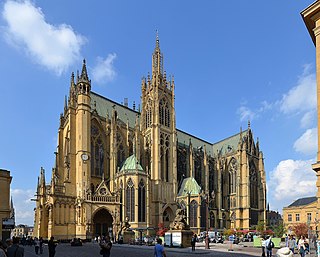
Metz Cathedral is the cathedral of the Catholic Diocese of Metz, the seat of the bishops of Metz. It is dedicated to Saint Stephen. The diocese dates back at least to the 4th century and the present cathedral building was begun in the early 14th century. In the mid-14th century, it was joined to the collegiate church of Notre-Dame, and given a new transept and late Gothic chevet, finished between 1486 and 1520. The cathedral treasury displays a rich collection assembled over the long centuries of the history of the Metz diocese and include sacred vestments and items used for the Eucharist.
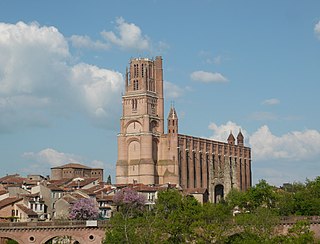
The Cathedral of Saint Ceciliaof Albi, also known as Albi Cathedral, is the seat of the Catholic Archbishop of Albi. First built in the aftermath of the Albigensian Crusade, the grim exterior resembles a fortress, but the interior is lavishly decorated with art and sculpture, a very ornate choir screen, and walls in bright blues and golds, in the Toulousian or Southern French Gothic style. It was begun in 1282 and was under construction for 200 years. It is claimed to be the largest brick building in the world. In 2010 the cathedral, along with its episcopal buildings, was designated a UNESCO World Heritage Site because of its unique architecture and the remarkable consistency in its design.

Bordeaux Cathedral, officially known as the Primatial Cathedral of St Andrew of Bordeaux, is a Catholic church dedicated to Saint Andrew and located in Bordeaux, France. It is the seat of the Archbishop of Bordeaux.

Rodez Cathedral is a Roman Catholic church located in town of Rodez, in the department of Aveyron in the Occitanie region of Southern France. The cathedral is a national monument and is the seat of the Bishopric of Rodez. The west front, of a military appearance and without a portal, formerly was part of the city wall of Rodez. Notable elements include a Flamboyant Gothic and Renaissance tower, and a Renaissance rood screen and choir stalls.

Troyes Cathedral is a Catholic church, dedicated to Saint Peter and Saint Paul, located in the town of Troyes in Champagne, France. It is the episcopal seat of the Bishop of Troyes. The cathedral, in the Gothic architectural style, has been a listed monument historique since 1862.

Toulouse Cathedral is a Roman Catholic church located in the city of Toulouse, France. The cathedral is a national monument, and is the seat of the Archbishop of Toulouse. It has been listed since 1862 as a monument historique by the French Ministry of Culture.

The Basilica of Saint Clotilde is a basilica church located on the Rue Las Cases, in the 7th arrondissement of Paris. It was constructed between 1846 and 1856, and is the first example of a church in Paris in the neo-Gothic style.

Santa Maria del Pi is a 15th-century Gothic church in Barcelona, Catalonia, Spain. It is situated on the Plaça del Pi, in the Barri Gòtic district of the city.

St Martin's Cathedral is a cathedral in Slovakia. It is located in the town of Spišská Kapitula and is the cathedral church of the Spiš diocese.
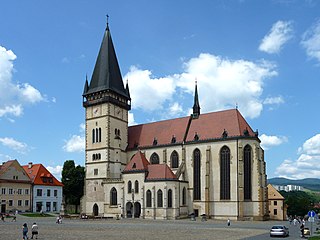
Basilica of St Giles in Bardejov, Slovakia, is a Gothic sacral building, which is situated in the northern part of the Town-Hall square. Bardejov is located in the larger area of town Prešov in the region called Šariš.
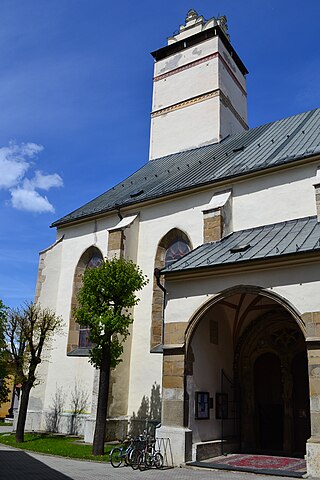
The Basilica minor of the Exaltation of the Holy Cross is a Late Gothic three-nave Catholic church located in the town of Kežmarok in the Spiš region of eastern Slovakia.

St. Castulus church is a Gothic church with Romanesque and Baroque elements. It is located on the Castulus square, in Old town near Convent of Saint Agnes. It is the only church in the Czech Republic consecrated to Saint Castulus.

Gothic cathedrals and churches are religious buildings created in Europe between the mid-12th century and the beginning of the 16th century. The cathedrals are notable particularly for their great height and their extensive use of stained glass to fill the interiors with light. They were the tallest and largest buildings of their time and the most prominent examples of Gothic architecture. The appearance of the Gothic cathedral was not only a revolution in architecture; it also introduced new forms in decoration, sculpture, and art.

The Catholic parish church St. Ulrich is a Baroque church of the 18th century in Amendingen.






